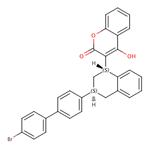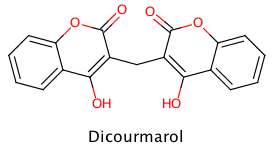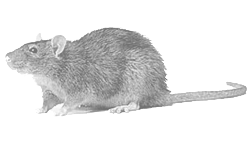Rat Poison

Two years ago, whilst clearing my garden shed I discovered that a pack of
bird food that I had inadvertently left out had been scattered all over the floor,
and mixed with what were, all too obviously, rat droppings. I also discovered a
rat hole in the back of the shed. Bristol City Council responded promptly, and
sent a member of their
pest control team who laid poison (little blue granules
in a tray beside the hole), and returned a week later to check for any dead rats.
I never found a dead one, and don't think they are still resident under the shed.
We have three cats, so I had half expected to be treated to an 'offering' if
a dead rat was found!
It is doubtful that the 'blue pellets' contained Warfarin since most rats have
developed some immunity to Warfarin, and other more potent coumarins such as
Brodifacoum (left) have been substituted. It is also likely that the rats
treated the poison with the suspicion they reserve for new foods.
They learn fast!
"... brodifacoum is classified as "extremely toxic" (LD50 < 1.0 mg/kg b.w.) and "very toxic" (T+; LD50 <
25 mg/kg b.w.), respectively. Because of its persistency, cumulative potential and
high toxicities for various wildlife species, it is also considered an environmental
pollutant (N; noxious to the environment). The readiness of brodifacoum to penetrate intact
skin should be noted, and brodifacoum and commercial preparations containing it should be
handled with respective care and precaution because of its skin resorptivity.
The estimated average fatal dose for an adult man (60 kg b.w.) is about 15 mg, without
treatment. However, due to low bait concentrations (usually 10 — 50 mg/kg bait, i.e.
0.001 — 0.005%) and slow onset of symptoms, and the existence of a highly effective
antidote (appropriately dosed vitamin K1), brodifacoum is considered to be of
relatively low hazard to humans ..." -
Wikipedia
The so-called "super warfarins" are second generation rodenticides, difenacoum, brodifacoum,
and a fluorine derivative coumarin, flocoumafen. Difethialone
3-[3-[4-(4-bromophenyl)phenyl]-1-tetralinyl]- 2-hydroxy- 4-thiochromenone, is banned in the USA.
All the super-warfarins are extremely hazardous to wildlife, especially birds of prey.
Dicoumarol and WARFarin
In the early 1920s some North American cattle were found to be very susceptable
to haemorrhaging after veterinary operations such as dehorning and castration, the
problem was traced to mouldy silage, and later shown to be due to a lack of
prothrombin, so interfering with blood clotting in the animals. The disease was
named "sweet clover disease", but it's cause remained a mystery until a local
farmer asked Professor Karl Link, a biochemist in University of Wisconsin, to investigate.
"One snowy morning in February, 1933, Ed Carlson, a farmer from Deer Park, Wisconsin,
came into Karl Paul Link's laboratory carrying a milk-can full of blood that refused
to coagulate. Outside he had a small heap of spoiled sweet clover hay and a dead
heifer freezing in the back of his truck."
 Link and his students eventually isolated and characterised dicoumarol as the poison
causing the illness. Link and some of his students then discovered another,
more potent coumarin which they patented in 1954, and named Warfarin. WARF is
Wisconsin Alumni Research Foundation.
As with the cattle, warfarin disrupts the animal's blood clotting mechanism, and the rats
die from internal bleeding a few days after eating poisoned bait.
Warfarin began use in the early 1950s, but within ten years rats were showing resistance
to warfarin as resistant genes spread in the rat population.
See a view that
"Fat rats love their poison" from New Scientist! Warfarin
resistance in rats builds up very rapidly due to the
very high mortality rate (95%), and rat fecundity, so the warfarin resistant gene (Rw)
provides a useful model to study "natural selection mapping" and provide a
direct means to detect and map genes that are the object of natural selection.
{"Natural selection mapping of the warfarin-resistance gene" M.H.Kohn,
H-J.Pelz, and RK.Wayne,
Proc Natl Acad Sci U S A. 2000, 97(14), 7911.}
Increasing resistance to Warfarin poisoning also becomes a target for mistaken and distorted
'creationist'
arguments!
Link and his students eventually isolated and characterised dicoumarol as the poison
causing the illness. Link and some of his students then discovered another,
more potent coumarin which they patented in 1954, and named Warfarin. WARF is
Wisconsin Alumni Research Foundation.
As with the cattle, warfarin disrupts the animal's blood clotting mechanism, and the rats
die from internal bleeding a few days after eating poisoned bait.
Warfarin began use in the early 1950s, but within ten years rats were showing resistance
to warfarin as resistant genes spread in the rat population.
See a view that
"Fat rats love their poison" from New Scientist! Warfarin
resistance in rats builds up very rapidly due to the
very high mortality rate (95%), and rat fecundity, so the warfarin resistant gene (Rw)
provides a useful model to study "natural selection mapping" and provide a
direct means to detect and map genes that are the object of natural selection.
{"Natural selection mapping of the warfarin-resistance gene" M.H.Kohn,
H-J.Pelz, and RK.Wayne,
Proc Natl Acad Sci U S A. 2000, 97(14), 7911.}
Increasing resistance to Warfarin poisoning also becomes a target for mistaken and distorted
'creationist'
arguments!



 Link and his students eventually isolated and characterised dicoumarol as the poison
causing the illness. Link and some of his students then discovered another,
more potent coumarin which they patented in 1954, and named Warfarin. WARF is
Link and his students eventually isolated and characterised dicoumarol as the poison
causing the illness. Link and some of his students then discovered another,
more potent coumarin which they patented in 1954, and named Warfarin. WARF is